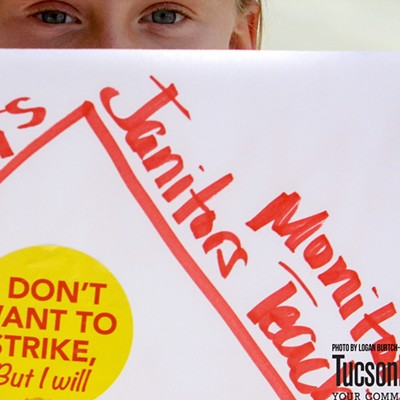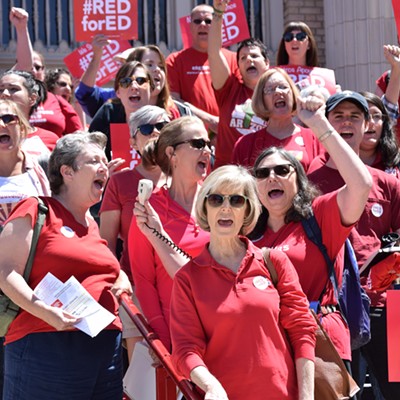Over the past year, this column has dealt with Riemann surfaces, Galois Theory, Direchlet boundary conditions, differential geometry and algebraic topology—topics in higher math that reflect the general intellectual level of our readers. However, every now and then, we have to take several steps back to some pretty basic concepts to help correct an oft-repeated misconception that has become part of the public discourse. These days, we're dealing with a false notion that was started either by people who didn't understand the basic math, or, more likely (and in a more sinister manner), by people who did understand the math but simply twisted and lied about it to advance a political agenda.
Last week, I got a long email from somebody (I'll call him Lance, since he used one of those fake email names that screams "I'm-mad-as-hell-but-not-enough-to-use-my-real-name",) who told me that it was about time that I stop supporting public schools and recognize the future by getting on the charter school bandwagon. According to the emailer (I'm paraphrasing here), charter schools do a better job of educating kids than do real public schools (wrong!); they get by on less money than public schools (wrong-a-dee-wrong-wrong); they have better teachers than public schools (wrong-aronamus rex); and they have administrative staffs that are more streamlined and more efficient (wrong-a-palooza).
He then repeated the rant du jour that not enough money is "getting to the classroom." This was cited when Gov. Doug Ducey pulled his sleight of hand by claiming that he was increasing spending for schools when he was actually decreasing it in one part of the educational budget and shifting the money from one side of the table to the other. Lance and many others have said that, in several school districts, the percentage of money "getting to the classroom" has decreased in the years since the economy crashed. In many cases, that's true, but poor Lance doesn't realize that he's actually making my argument for me.
Let's say that in 2008, a school was getting a certain amount of money. For each $100 it had to spend, $46 of it went to things like buses and bus drivers; maintenance and custodial services; electric, water and gas bills; toilet paper, fuels costs and on and on and on ... and administrative salaries. This means that, put somewhat simplistically, $54 (or 54% of the money) gets to the classroom, mostly in the form of teacher salaries, books and supplies. That 54 percent figure is actually above average for the country; not spectacular, but pretty good.
So, the economy goes bad and the State Legislature, not wanting to go back on campaign promises of cutting taxes for rich people, takes the knife to school budgets, instead. Instead of that $100 it once had, the school now has $90. Those aforementioned expenses aren't going to change, although the costs of those things will inevitably tick upward, even in times of low inflation. You still need buses and bus drivers, toilet paper, electricity and janitors. The expenses stay the same, but suddenly, that $46 eats up 51 percent of the budget, meaning that only 49 percent is getting to the classroom. Nothing has changed, but the ostensibly sacrosanct getting-to-the-classroom percentage is down to a politically disturbing level. That's just one of the reasons why focusing on that percentage is, at the very least, misleading and, more correctly, just plain wrong.
Of course, cuts must be made and, unfortunately, all too often, teachers get cut first. You can cut an administrative position at a school and that could probably save 1.5 teaching positions. Even so, a reduction in funding is almost always going to result in the percentages heading in the wrong direction, at least for a while.
There are certainly districts that are top-heavy in central administration. You can cut 10 or 12 administrative positions and maybe save $1 million, but, spread out over an entire district, that might result in the saving of one teaching position per school. That's making the best of a bad situation, but the overall percentages will still be problematic for some.
Here in Arizona, we have an extra, special case. The voters of Arizona instructed the Legislature to come up with money to at least try to keep up with inflation. As we all know, the Legislature has refused to live up to its constitutional responsibilities for several years now. The courts have ruled that, for just one of those years, the Legislature owes the schools $331 million (and probably owes $1 billion more for other years). Most of that money would go for teacher pay, in one form or another.
The distribution of 301 monies would boost the "going into the classroom" side of the ledger. The illegal withholding of those funds, coupled with the fact that even with salary freezes and cutbacks, some unavoidable costs still go up, serves to tilt the balance away from the classroom.
It is at least disingenuous for Republican lawmakers to gut school spending, including a significant amount that would go into the classroom. and then publicly bemoan the classroom/non-classroom ratio. It's like the kid who kills both of his parents and then begs for mercy because he's all of a sudden an orphan.
You don't get to create the problem and then complain about the problem. Unless you're a Republican Legislator in Arizona.









